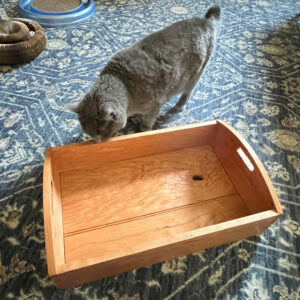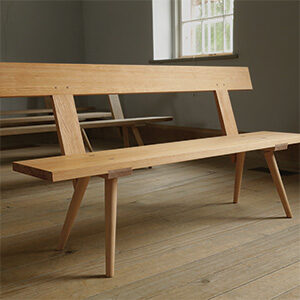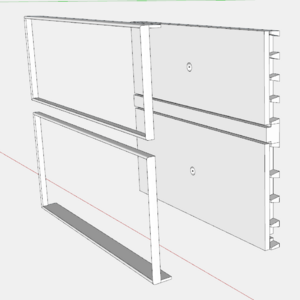Interesting dovetail layout tools
Do your dovetails go wrong at the dreaded "transfer?" If so, collinear marking might be the answer you've been looking for.
A few months ago, I received an email from a manufacturer asking if they could quote something I said on Shop Talk Live, our podcast. This has happened before, and I always want to make sure it isn’t viewed as an endorsement of a product. The quote they were hoping to use was ““Outside of sawing technique, most dovetailing issues can be traced back to a bad transfer from the tail board to the pin board.” I have likely said that many times on the podcast, so I can’t deny that one! Go ahead, I’ll stand behind that quote.
Whether you start pins first or tails first, the transfer between the two is the make or break spot for your dovetails. I would bet that most dovetail tips and tricks you see online are based around that very moment in the process. Christian Becksvoort uses a piece of wood in the drawer bottom groove to hold everything in place. FWW editor Michael Pekovich has his cool guide blocks to help align everything. Steve Latta is a fan of the rabbet to give you a ledge to hold the board against, and Megan Fitzpatrick uses her “Moxon Vise Support” to hold everything in place. There are certainly lots of tips to handle this most delicate of processes, but all of them have one thing in common–you are transferring from a pin board or tail board that is already cut. The upside of this is that if your cuts on the first board aren’t perfect, you now have a chance to match them on the second board. The downside—like I’ve said enough to be quoted—is that this is where it goes wrong for most people.
So what if you were able to lay out your tail board and your pin board in advance? I think every woodworker has had this thought and for some reason or another, no matter how careful you are, the layout just doesn’t match up. Well, TailSpin tools might have the answer–collinear marking. The video below will explain it better than I can, but I’ll try to give you the simple version. When you mark a line off of a ruler, the line never winds up EXACTLY next to the ruler. There is always some offset. The TailSpin tools have that offset built into them, so the line winds up exactly where you want it.
So, forget everything you know about your dovetailing workflow. If you’re already using a saw guide to cut dovetails, this system really makes sense. I have messed with the TailSpin collinear marking tools, and they really do what they promise. The lines wind up exactly where they are supposed to. I think that the change in workflow might be too radical for some, but for many, collinear marking might be the answer they’ve been looking for.
Fine Woodworking Recommended Products

Freud Super Dado Saw Blade Set 8" x 5/8" Bore

Suizan Japanese Pull Saw

Marking knife: Hock Double-Bevel Violin Knife, 3/4 in.























Comments
“[Deleted]”
Seems to me that if you need to Mark it both pins and tails before any saying, you would*have* to use a guide block to guide your saw.
Otherwise any deviation in your first cuts, whether you prefer pins or tails first, could not be corrected for in marking your second cuts. Since they were all laid out in advance.
Of course, if all your sawcuts were always perfect, this would be no issue. Funny thing, when I watch videos of experts cutting dovetails, they make less than perfect cuts sometimes.
I'm not quite getting the concept.
As best as I can figure, what the device does is allows you to align the third line with the previous two, abutting the second gauge to the first. Sort of clever, but not sufficiently to offset the issue of misalignment of mating surfaces due to sawing errors.
Other than align the third line to the previous two, it doesn't seem to do anything that a regular square or dovetail marker doesn't do, since two of the three lines are done by aligning the first gauge to the layout mark, as any other dovetail marker does. So all it gets you is a third line that aligns with the other two without the need of a bit of trial and error in positioning the dovetail marker so that the third line is aligned with the two previous pencil lines.
I consider myself an intermediate dovetailer. I was taught at North Bennett in one of their 2-week hand tool classes. I've made quite a few dovetailed drawers and cases since. They're never perfect -- always a gap here or there. So I was willing to try the Tailspin tools. I just finished my first 8 joints with them. And I've done no better, really, than with any other technique, but it was quicker. The layout of the tail and pin boards together saves time. But you're still going to have cut perfectly straight tails for them to fit together w/o gaps, and that didn't happen anymore than with any other method. I don't use a guide, maybe that's why.
I've come to believe that perhaps cutting tails by machine (either with a router jig or with an angled table saw blade might be the best start. I've never found the transfer to be the issue. Mike Pecovich's little aligment jigs work just fine for me. I haven't gone this route yet. I'm going to try the Tailspin tools a bit more, but I may wind up just using them for tail layout (if I stick with hand cut tails) and then do the transfer.
Maybe they're just right for some people, but for me they were just a slightly quicker way to make functional but not spectacular joints.
Literally a solution looking for a problem.
Log in or create an account to post a comment.
Sign up Log in